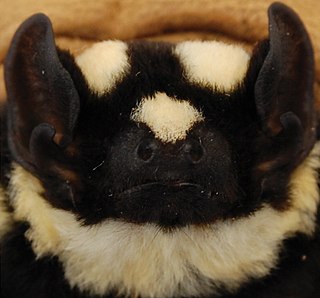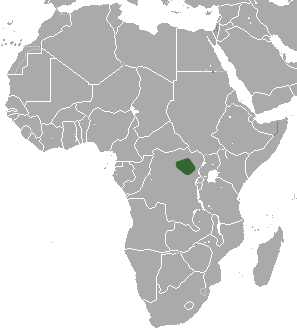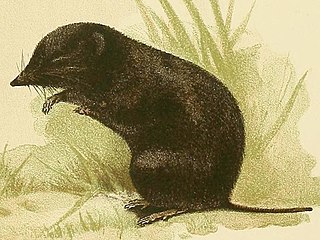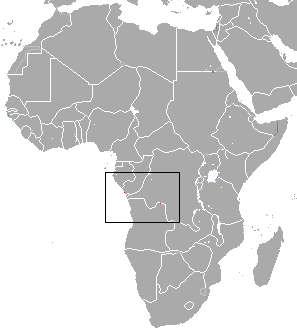
Brachystegia is a genus of tree of the subfamily Detarioideae that is native to tropical Africa.

Aonyx is a genus of otters, containing three species, the African clawless otter, the Congo clawless otter, and the Asian small-clawed otter. The word aonyx means "clawless", derived from the prefix a- ("without") and onyx ("claw/hoof").

Ancistrocladus is a genus of woody lianas in the monotypic family Ancistrocladaceae. The branches climb by twining other stems or by scrambling with hooked tips. They are found in the tropics of the Old World.

Pousargues's mongoose, also known as the African tropical savannah mongoose, is a mongoose native to Central Africa. It is listed as data deficient on the IUCN Red List as little is known about its distribution and ecology. It is the only species in the genus Dologale.

Macrothele is a genus of mygalomorph spiders in the family Macrothelidae, and was first described by A. Ausserer in 1871. Most species occur in Asia, from India to Japan, and Java, with five found in Africa, and two in Europe. The name is derived from Ancient Greek μακρός ("makro-"), meaning "big", and θηλή ("thele"), referring to the spinnerets.

The pied butterfly bat, also known as the pied bat or badger bat, is a rare species of vesper bat in the family Vespertilionidae.
The mouselike pipistrelle is a species of vesper bat in the family Vespertilionidae. It is found in Cameroon, Republic of the Congo, Democratic Republic of the Congo, and Gabon. Its natural habitats are subtropical and tropical dry and moist lowland forests.

The Congo serpent eagle is a species of bird of prey in the family Accipitridae. It is the only member of the monotypic genus Dryotriorchis, although it was formerly placed in Circaetus. This species is distributed across the African tropical rainforest, including upper and lower Guinean forests. This serpent eagle specializes in hunting in these forests’ dark understories. It has two subspecies, the nominate subspecies Dryotriorchis spectabilis spectabilis and Dryotriorchis spectabilis batesi. Though monotypic, it appears to be very closely related to Circaetus. This hawk is a medium-sized bird with distinctive short, rounded wings and a long, rounded tail. It is varying shades of brown on its back and has a slight crest. Its breast is white with variable amounts of a rufous wash and, in the nominate subspecies, is covered in round, blackish spots. The subspecies D. s. batesi only has these dots on its flanks. The Congo serpent eagle closely resembles Cassin's hawk-eagle, and some ornithologists believe that this likeness is a rare example of avian mimicry. It is a very vocal raptor, and often is one of the most heard species in its habitat.

The yellow-throated leaflove is a species of leaflove in the bulbul family of passerine birds. It is the only species of the monotypic genus Atimastillas. The yellow-throated leaflove is found in western and central Africa. Its natural habitats are subtropical or tropical dry forests, moist savanna, and subtropical or tropical moist shrubland.

Brazza's martin is a passerine bird in the swallow family, Hirundinidae. It is 12 centimeters (4.7 in) long with grey-brown upperparts, heavily black-streaked white underparts, and a brownish tint to the breast plumage. The sexes are similar, but juvenile birds have more diffuse breast streaking and reddish-brown edges to the feathers of the back and wings. The song consists of a series of short notes of increasing frequency, followed by a complex buzz that is sometimes completed by a number of clicks.

The red-headed quelea is a species of bird in the family Ploceidae. It is found in Angola, Benin, Botswana, Burkina Faso, Burundi, Cameroon, Central African Republic, Chad, Republic of the Congo, Democratic Republic of the Congo, Ivory Coast, Equatorial Guinea, Eswatini, Ethiopia, Gabon, Gambia, Ghana, Guinea, Guinea-Bissau, Kenya, Liberia, Malawi, Mali, Mozambique, Niger, Nigeria, Rwanda, São Tomé and Príncipe, Senegal, Sierra Leone, South Africa, South Sudan, Tanzania, Togo, Uganda, Zambia, and Zimbabwe.
The Congo shrews, members of the genus Congosorex, are mammals in the family Soricidae. The genus contains these species:

Latona's shrew is a species of shrew in the genus Crocidura. It is endemic to Democratic Republic of the Congo. Its natural habitat is subtropical or tropical moist lowland forests.

Myosorex is a mammal genus in the Soricidae (shrew) family. The genus, collectively referred to as the mouse shrews, contains these species:

The lesser Angolan epauletted fruit bat is a species of megabat in the family Pteropodidae. It is found in Angola and the Republic of the Congo. Its natural habitats are subtropical or tropical dry and moist lowland forest, and savanna.

Woermann's bat or Woermann's fruit bat is a species of megabat in the family Pteropodidae. It is monotypic within the genus Megaloglossus. It is found in Angola, Benin, Cameroon, Central African Republic, Republic of the Congo, Democratic Republic of the Congo, Ivory Coast, Equatorial Guinea, Gabon, Ghana, Guinea, Liberia, Nigeria, Sierra Leone, Togo, and Uganda. Its natural habitats are subtropical or tropical moist lowland forests and moist savanna.
Thomandersia is the sole genus in the Thomandersiaceae, an African family of flowering plants. Thomandersia is a genus of shrubs and small trees, with six species native to Central and West Africa.

According to the current taxonomy, the Myosoricinae are a subfamily of shrews. As such, they form one of three main types of shrews, the other two being the red-toothed shrews and the white-toothed shrews. They are the only one of the three to be found exclusively south of the Sahara Desert, and so they have been described in English as the African shrews, but also many white-toothed shrews are in Africa and therefore this term is more generally used for shrews from Africa in general. The subfamily has three genera and 20 species:
Podococcus is a genus of palms found in tropical Africa. It includes two recognized species:

Chrysopolominae is a subfamily of moths in the family Limacodidae. The type genus of this subfamily is Chrysopoloma. Chrysopolominae was originally a family (Chrysopolomidae) under the superfamily Zygaenoidea, consisting of two subfamilies, including about 30 species distributed in Africa, but in other newer documents, this family was downgraded and became It is a subfamily under Limacodidae, which belongs to the superfamily of Zygaenoidea, and the two subfamilies originally under Chrysopolominae were merged to become the synonym of Chrysopolominae called Ectropinae.
















